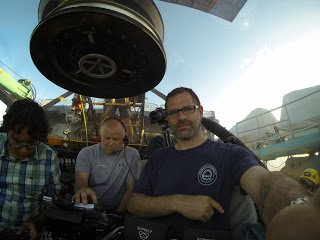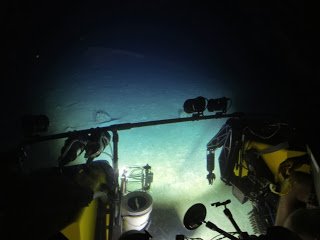 Among the ambitious field agenda for this expedition to continue fluorescence exploration in the Solomon Islands
Among the ambitious field agenda for this expedition to continue fluorescence exploration in the Solomon Islands
is carrying out the work across the full spectrum of depths – from shallow flats and mangroves, to coral reefs, through the mesophotic zone, to scratching the surface of the aphotic realm, where light fades to black.
Complicating this ambitious effort is that numerous modes of diving are required to access each respective environment. In this case, snorkeling, scuba, and manned submersibles.
Over the last couple of nights, I’ve made my way into the sub rotation and have made the journey into the deep. The dives have been made at night, by necessity, to take full advantage of the custom low light and fluorescent imaging systems developed by the project team – a collaboration between researchers at the American Museum of Natural History, the City University of New York, and Yale University.
 |
| Locked in and prepping for descent. |
 |
| View from inside the sub at just shy of 1000 feet. A whole new dimension of ocean space. |
Descending through the darkness we see a variety of glowing creatures – those that bioluminesce, or create their own light – and some species that migrate to the shallows from abyssal depths to feed. It’s a very unusual sight to see deepwater fishes firsthand when human eyes typically only see these critters when they come up in trawls. While we see these elusive creatures, the search is on for those that fluoresce – or emit unique patterns of visible light as the result of their bodies’ proteins absorbing various wavelengths of stimulating light. The function of this fluorescence phenomenon in many species remains a mystery, and the potential to discover novel sources of fluorescent proteins, or even new fluorescent proteins could prove to benefit medical research. Fluorescent proteins are used today as biomarkers for a wide range of interesting work with implications from brain activity studies to cancer research.
Once bottoming out the vertical reef at 150 meters depth or so, the bottom slopes more gradually down to about 300 meters depth. It’s a very barren seascape, though attention is kept by the occasional tunicate, crinoid, urchin, or odd fish.
While the sub offers tremendous observation capabilities by putting the human eye at these depths that are beyond scuba accessibility, we remain limited by ‘being there’. That is, immersed in the environment with the situational and spatial awareness of a human being, able to respond to the environment, and capable of using our own hands to carry out a task.
While this, and other subs, are equipped with collection tooling, there remain limitations. This is among the many reasons why I am excited about the prospective use of the Exosuit ADS for future scientific expeditions. While presenting its own set of limitations, the technology may provide the balance between scuba and subs to carry out delicate manipulated experiments within this area of interest.
My ride(s) in the sub are novel experiences, and tremendously valued. In just a few short hours I was afforded a glimpse of the ocean that so very few will ever have firsthand, and was able to see yet another massive ocean of opportunity there on the ocean floor.
For more from the author, visit oceanopportunity.com.
Donate today to enable exploration and to keep related content coming!
![]()

